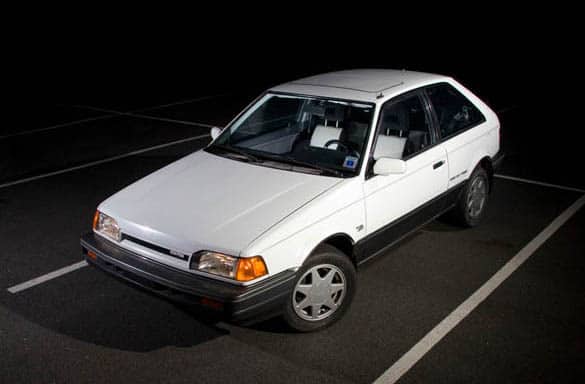I have to admit at first glance the Mazdaspeed 3 looked a little “off” with the smile in the front bumper. After spending quite a few hours with the car I can tell you with a straight face, you don’t even notice it. This may be different on a Mazdaspeed 3 that is not Black Mica like ours, where there is a bigger contrast in color between the car body and the bumper insert.
What I can tell you for sure is that cleaning the front bumper is not a lot of fun. Bugs get wedged in the strakes inside the insert quite easily and at weird angles. You have to get down low to get them all out of there. The wheels are not bad to clean nor is the rest of the body. The rear wing is an interesting design, it is basically a smaller wing with another wing over it.
Driving the car is great. The car seems to be planted better on the road compared to the older Mazdaspeed 3. I had a chance to go through some decent corners and get on the throttle a bit. You can feel the differential really pushing the outside tire to get you through the corner. It is quite a rewarding feeling having the car urging you to go faster. The car almost begs you to take a corner as fast as you can. The only two initial changes I would make to the handling are to make the Mazdaspeed 3 a little flatter in corners with some larger sway bars, and lower it around an inch or so to close up the wheel gap. The Dunlop SP 2050 tires seem decent but I have not had a chance to really push them to the limit to see what happens.
The exhaust note is very subtle and is quieter than the older Mazdaspeed 3 stock exhaust. You get a a small hint of the flat exhaust note but not a lot. The dual tips are also much nicer than what the pre-release pictures showed. The angle of the tips matching the bumper contour was a nice design touch as well.
There are a few items I wish Mazda would have given the North American market. Being that the sport model is the only version available we were not able to get the HID headlights and LED tail lights with the car. We’ll have to wait and see what kinds of options become available and see about changing the lights out with something better. On the plus side this is the first car I have had to actually “speak” with the car to setup the Bluetooth, and for making phone calls. The navigation works well from the limited places I have driven so far. I really love the boost gauge. It is a nice throwback to the old style of the turbine boost light from the 323 turbo.
So now that we have the car what are we going to do with it? Maybe a better question is what we are not going to do with it. We have quite a few projects planned for the new car. If you want to follow along with updates to this project and other CorkSport products be sure to sign up and follow us on Twitter at https://www.twitter.com/corksport or click the “Twitter” buttons above and below.
– Derrick












